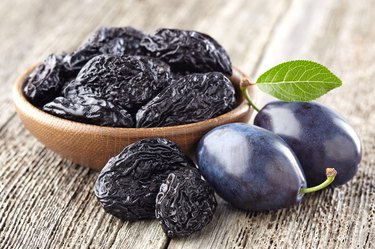
If you are a label reader and routinely check out the ingredients list of your favorite products, you might see one chemically sounding name — benzoic acid.
While some foods naturally contain benzoic acid, others have it added in, but is it something you need to worry about?
Video of the Day
Video of the Day
What Is Benzoic Acid, and How's It Different From Sodium Benzoate?
Benzoic acid, if it's not naturally in food, can be added to help adjust the pH of a packaged product. Basically, it reduces the pH to make it more acidic so yeasts and bacteria can't grow and spoil your food. It has been commonly used for about 100 years for food safety and preservation, per an older September 2009 report in Modern Biopolymer Science.
You may see benzoic acid on its own, but you also may see the name "sodium benzoate," which is simply the sodium salt of benzoic acid with a slightly different chemical structure. Sodium benzoate is not naturally occurring, but that doesn't mean it's harmful.
The World Health Organization (WHO) Joint Expert Committee on Food Additives first set the acceptable daily intake (ADI) level for benzoic acid and sodium benzoate in 1962. They concluded that it's safe to have benzoic acid in amounts of zero to 5 milligrams per kilogram (2.2 pounds) of body weight. And then in 2021, the WHO increased the ADI of benzoic acid to between zero and 20 milligrams per kilogram (2.2 pounds) of body weight.
So, what does this mean for you? To put it in context — a person weighing 150 pounds will have an ADI of zero to 341 milligrams of benzoic acid.
In addition to this, the Food and Drug Administration has set a maximum allowable amount of 0.1 percent of sodium benzoate in food and considers benzoic acid generally recognized as safe (GRAS) at allowable levels.
Benzoic Acid in Food
A number of foods naturally contain benzoic acid, but the amounts vary. Typically, foods with naturally occurring benzoic acid have very small amounts.
Some natural sources of benzoic acid include:
- Fruits: Apricots, prunes, berries, cranberries, peaches, kiwi, bananas, watermelon, pineapple, oranges
- Spices: Cinnamon, cloves, allspice, cayenne pepper, mustard seeds, thyme, turmeric, coriander
- Vegetables: Mushrooms (fungus), snap peas, cucumbers, radishes, cabbage, potatoes, onions, garlic, spinach
- Nuts: Cashews, almonds, pistachios
- Dairy: Yogurt, cheese, milk
Most fruits, vegetables and nuts do not contain over 2 milligrams of benzoic acid per kilogram, according to an extensive May 2017 review in Critical Reviews in Food Science and Nutrition.
Strawberries have up to 29 milligrams/kilogram. Dairy products tend to have slightly higher levels of benzoic acid than plant foods, up to 28 milligrams/kilogram reported in some cheeses, according to the above review. Naturally occurring benzoic acid in milk is between 2 to 5 milligrams/kilogram.
To put this in perspective, unless you're eating 2 pounds of cheese per day, your intake of naturally occurring benzoic acid will be fairly low.
It's hard to know exactly how much benzoic acid or sodium benzoate has been added to food. The FDA has maximal amounts for individual foods, but the amounts are not labeled on the packaging. If a food has benzoic acid added, you'll see benzoic acid or sodium benzoate in the ingredients list.
One of the most common food with benzoic acid or sodium benzoate added is soft drinks. Others include some canned and dried fruit, bakery items and other processed foods.
Other Uses for Benzoic Acid
Many cosmetics companies use benzoic acid as an ingredient in many products, like creams and lipsticks. You might also find benzoic acid or sodium benzoate in toothpaste, shower gel, shampoo, moisturizers and sunscreens, according to a March 2019 review in the Journal of Preventive Medicine and Hygiene.
Benzoic acid's use in this industry mirrors the food industry's purpose as a preservative — organic products are also allowed to use sodium benzoate in their products. Sodium benzoate was noted as the most common preservative in rinse-off products, according to the March 2019 review in the Journal of Preventive Medicine and Hygiene.
Safety Concerns
Ultimately, the choice in whether or not you eat or steer clear of benzoic acid or sodium benzoate is completely up to you. Studies indicating that it is harmful typically use amounts on animals that humans will most likely not take in a single serving, heightening any side effects that may occur.
A 2022 report from the WHO affirmed the organization's previous conclusion that neither benzoic acid or sodium benzoate could be considered carcinogenic based on available research, which is largely animal studies, not human trials. There is some research indicating that benzoic acid can react with ascorbic acid (vitamin C) and form the carcinogen benzene. But the 2022 WHO report concluded that benzene exposure from soda and other foods "is of little concern from a public health perspective."
Warning
If benzoic acid concerns you, contact your doctor. Benzoic acid is metabolized quickly in the body by the liver, according to December 2017 research in the International Journal of Toxicology. So, if you have altered liver function, it's definitely worth having a conversation.
- JAMA Network Open: "Effect of Sodium Benzoate vs Placebo Among Individuals With Early Psychosis"
- Regulatory Toxicology and Pharmacology: "Pharmacokinetic Data Reduce Uncertainty in the Acceptable Daily Intake for Benzoic Acid and Its Salts"
- Food and Drug Administration: "Benzoic Acid"
- Critical Reviews in Food Science and Nutrition: "Benzoic Acid and its Derivatives as Naturally Occurring Compounds in Foods and as Additives: Uses, Exposure, and Controversy"
- Journal of Preventive Medicine and Hygiene: "Skin Safety and Health Prevention: An Overview of Chemicals in Cosmetic Products"
- International Journal of Toxicology: "Safety Assessment of Benzyl Alcohol, Benzoic Acid and its Salts, and Benzyl Benzoate"
- WHO: "Evaluations of the Joint FAO/WHO Expert Committee on Food Additives (JECFA)"
- WHO: "Evaluation of Certain Food Additives"